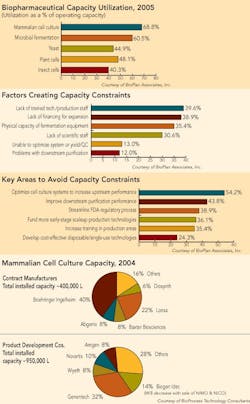For those in the biopharmaceutical industry concerned about dwindling cell culture capacity (Pharmaceutical Manufacturing,Nov./Dec. 2004, p. 12), there is good news. Capacity utilization dropped measurably in the past two years, according to BioPlan Associates (Rockville, Md.) third annual biopharma manufacturing capacity survey, which polled 187 biopharma executives. Utilization of mammalian systems fell from 76% in 2003 to 68.8% in 2005.Continued capacity expansion (particularly in microbial volume), improved yields and expression levels and the failure of several late-stage products explain the lower utilization data, says Eric Langer, president of BioPlan and one of the authors of a recently published report on the survey. But while contract manufacturing organizations (CMOs) seem to have adequate or excess capacity, biotherapeutic developers who manufacture biologics may be experiencing a slight capacity crunch, Langer says.Demand for capacity should remain healthy nonetheless, driven by increased sales and new product approvals, notes Howard Levine, Ph.D., of BioProcess Technology Consultants (Acton, Mass.) and another of the reports authors. Expanded facilities will mean more large-scale players with a broader distribution of capacity. Increases in volumetric productivities may eliminate bioreactor capacity as the capacity-limiting factor in many facilities, Levine says.Biomanufacturers seem to have other concerns, in fact, one being a lack of trained, experienced technicians and production staff. Nearly 40% of those surveyed said that this issue may cause capacity constraints by 2010. More than 30% were concerned about a lack of scientific staff.Equipment availability is also a problem. While the use of disposables continues to rise, as manufacturers seek to minimize contamination risks, 57% of respondents were concerned about overdependence on a single vendor. The fallout, says Langer, is more interest in standardization of components and interchangeability of vendors.For more information on the survey and report, visit www.bioplanassociates.com. To access Langer's PowerPoint presentation, "Biopharmaceutical Manufacturing Capacity and Production Trends," click the Download Now button below the graphics.
Latest from Home
Latest from Home







